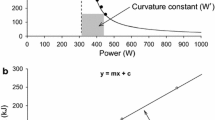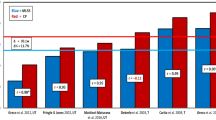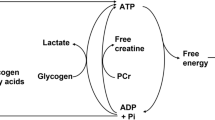Abstract
Critical power (CP) is a fundamental concept describing fatigue and exhaustion. The main physiological determinant of CP is the ability to utilise oxygen. This in turn is dependent primarily on diffusion distance. During exercise, many different tissue systems must increase their metabolic demand. It is argued that each tissue system, such as cardiac, respiratory and leg muscles, has their own CP. Cardiac muscle has the greatest CP relative to its maximum power because it has the shortest diffusion distances. Respiratory muscle also has a substantially higher relative CP than leg muscle. The higher relative CPs of cardiac and respiratory muscle are due in part to the homeostatic functions these tissues provide. This built in protective design can be disrupted in certain conditions such as hypoxia. During high intensity exercise, fatigue and ensuing exhaustion will occur if any contributing physiological system functions above its CP.






Similar content being viewed by others
References
Gandevia SC, Enoka RM, McComas AJ, et al., editors. Fatigue: neural and muscular mechanisms. New York (NY): Plenum Press, 1995 (Advances in Experimental Medicine and Biology; 338)
Porter R, Whelan J, editors. Human muscle fatigue: physiological mechanisms. London: Pitman Medical, 1981 (Ciba Foundation Symposium; 82)
Sargeant AJ, Kernell D, editors. Neuromuscular fatigue. Amsterdam: North-Holland, 1993
Monod H, Scherrer J. The work capacity of a synergic muscle group. Ergonomics 1965; 8: 329–38
Moritani T, Nagata A, deVries H, et al. Critical power as a measure of physical work capacity and anaerobic threshold. Ergonomics 1981; 24: 339–50
Jenkins DG, Quigley BM. The influence of high-intensity exercise training on the Wlim-Tlim relationship. Med Sci Sports Exerc 1993; 25: 275–82
Hill DW. The critical power concept: a review. Sports Med 1993; 16 (4): 237–54
Poole DC, Ward SA, Gardner GW, et al. Metabolic and respiratory profile of the upper limit for prolonged exercise in man. Ergonomics 1988; 31 (9): 1265–79
Whipp BJ. The bioenergetic and gas exchange basis of exercise testing. Clin Chest Med 1994; 15: 173–92
Bigland-Ritchie B, Woods JJ. Changes in muscle contractile properties and neural control during human muscular fatigue. Muscle Nerve 1984; 7: 691–9
Jenkins DG, Quigley BM. The y-intercept of the critical power function as a measure of anaerobic work capacity. Ergonomics 1991; 34 (1): 13–22
Fukuba Y, Whipp BJ. The ‘endurance parameter ratio’ of the power-duration curve and race variation strategy for distance running. In: Steinacker JM, Ward S, editors. The physiology and pathophysiology of exercise tolerance. New York (NY): Plenum Press, 1996: 321–8
Tan LB. Clinical and research implications of new concepts in the assessment of cardiac pumping performance in heart failure. Cardiovasc Res 1987; 21: 615–22
Kumada M, Azuma T, Matsuda K. The cardiac output-heart rate relationship under different conditions. Jpn J Physiol 1967; 17: 538–55
Whipp BJ, Huntsman DJ, Storer TW, et al. A constant which determines the duration of tolerance to high-intensity work [abstract]. Fed Proc 1982; 41: 1591
Linnarsson D, Karlsson J, Fagraeus L, et al. Muscle metabolites and oxygen deficit with exercise in hypoxia and hyperoxia. J Appl Physiol 1974; 36: 399–402
Walsh ML, Banister EW. Possible mechanisms of the anaerobic threshold: a review. Sports Med 1988; 5: 269–302
Walsh ML, Banister EW. The influence of inspired oxygen on the oxygen uptake response to ramp exercise. Eur J Appl Physiol 1995; 72: 71–5
Walsh ML, Banister EW. Acute ventilatory response to ramp exercise while breathing hypoxic, normoxic, or hyperoxic air. In: Semple SJG, Adams L, editors. Modelling and control of ventilation. New York (NY): Plenum Publishing, 1995: 143–6 (Advances in Experimental Medicine and Biology; 393)
Yoshida TM, Chida MM, Ichioka M, et al. Effect of hypoxia on lactate variables during exercise. J Hum Ergol 1987; 16: 157–61
Honig CR, Connett RJ, Gayeski TEJ. O2 transport and its interaction with metabolism: a systems view of aerobic capacity. Med Sci Sports Exerc 1992; 24 (1): 47–53
Wilson DF, Erecinska M, Drown C, et al. The oxygen dependence of cellular energy metabolism. Arch Biochem Biophys 1979; 195: 485–93
Jenkins DG, Quigley BM. Endurance training enhances critical power. Med Sci Sports Exerc 1992; 24 (11): 1283–9
Stainsby WN, Snyder B, Welch HG. A pictographic essay on blood and tissue oxygen transport. Med Sci Sports Exerc 1988; 20: 213–21
Constable SH, Favier RJ, McLand JA, et al. Energy metabolism in contracting rat skeletal muscle: adaptation to exercise training. Am J Physiol 1987; 253 (2 Pt 1): C316–22
Dudley GA, Tullson PC, Terjung RL. Influence of mitochondrial content on the sensitivity of respiratory control. J Biol Chem 1987 Jul; 262 (19): 9109–14
McAllister RM, Terjung RL. Training-induced muscle adaptations: increased performance and oxygen consumption. J Appl Physiol 1991; 70 (4): 1569–74
Hoppeler H, Mathieu O, Weibel ER, et al. Design of the mammalian respiratory system: VIII. Capillaries in skeletal muscles. Respir Physiol 1981; 44: 129–50
Schaper J, Meiser E, Stammler G. Ultrastructural morphometric analysis of myocardium from dogs, rats, hamster, mice, and from human hearts. Circ Res 1985 Mar; 56 (3): 377–91
Martin B, Heintzelman M, Chen H-I. Exercise performance after ventilatory work. J Appl Physiol 1982; 52 (6): 1581–5
Shepard RJ. The maximum sustained voluntary ventilation in exercise. Clin Sci 1967; 32: 167–76
Whipp BJ, Pardy RL. Breathing during exercise. In: Geiger SR, editor. Handbook of physiology. Vol. III. Bethesda (MD): American Physiological Society, 1986: 605–29
Navaratnam V. Heart muscle: ultrastructural studies. Cambridge: Cambridge University Press, 1987
Bigland-Ritchie B, Vollestad NK. Hypoxia and fatigue: how are they related? In: Sutton JR, Houston CS, Coates G, editors. Hypoxia: the tolerable limits. Indianapolis (IN): Benchmark Press, 1988: 315–28
Lawler J, Powers SK, Thompson D. Linear relationship between V̇O2max and V̇O2max decrement during exposure to acute hypoxia. J Appl Physiol 1988; 64: 1486–92
Wagner PD. An integrated view of the determinants of maximum oxygen uptake. In: Gonzalez NC, Fedde MR, editors. Oxygen transfer from atmosphere to tissues. New York (NY): Plenum Press, 1988: 245–56 (Advances in Experimental Medicine and Biology: 227)
Sheriff DD, Rowell LB, Scher AM. Is the rapid rise in vascular conductance at onset of dynamic exercise due to muscle pump? Am J Physiol 1993; 265 (4 Pt 2): H1227–34
Ekblom B, Astrand P-O, Saltin B, et al. Effect of training on circulatory response to exercise. J Appl Physiol 1968; 24: 518–28
Boutellier U, Piwko P. The respiratory system as an exercise limiting factor in normal sedentary subjects. Eur J Appl Physiol 1992; 64: 145–52
Brooks GA, Fahey TD. Exercise physiology: human bioenergetics and its applications. New York (NY): John Wiley & Sons, 1984
Bellemare F, Bigland-Ritchie B. Assessment of human diaphragm strength and activation using phrenic nerve stimulation. Respir Physiol 1984; 58: 263–77
Dempsey JA, Babcock MA. An integrative view of limitations to muscular performance. In: Gandevia SC, Enoka RM, McComas AJ, et al., editors. Fatigue: neural and muscular mechanisms. New York (NY): Plenum Press, 1995: 393–9 (Advances in Experimental Medicine and Biology; 338)
McKenzie DK, Bellemare F. Respiratory muscle fatigue. In: Gandevia SC, Enoka RM, McComas AJ, et al., editors. Fatigue: neural and muscular mechanisms. New York (NY): Plenum Press, 1995: 401–14 (Advances in Experimental Medicine and Biology; 338)
Weibel ER, Taylor CR, Gehr P, et al. Design of the mammalian respiratory system: IX. Functional and structural limits for oxygen flow. Respir Physiol 1981; 44: 151–64
di Prampero PE, Ferretti G. Factors limiting maximal oxygen consumption in humans. Respir Physiol 1990; 80: 113–28
Edwards RHT. Interaction of chemical with electromechanical factors in human skeletal muscle fatigue. Acta Physiol Scand 1986; 128 Suppl. 556: 149–55
Saltin B, Strange S. Maximal oxygen uptake: ‘old’ and ‘new’ arguments for a cardiovascular limitation. Med Sci Sports Exerc 1992; 24: 30–7
Spriet LL, Gledhill N, Froese AB, et al. Effect of graded erythrocythemia on cardiovascular and metabolic responses to exercise. J Appl Physiol 1986; 61: 1942–8
Powers SK, Jacques M, Richard R, et al. Effects of breathing a normoxic He-O2 gas mixture on exercise tolerance and V̇O2max. Int J Sports Med 1986; 7: 217–21
Secher NH, Clausen JP, Klausen K, et al. Central and regional circulatory effects of adding arm exercise to leg exercise. Acta Physiol Scand 1977; 100: 288–97
Powers SK, Jacques M, Richard R, et al. Effects of breathing a normoxic He-O2 gas mixture on exercise tolerance and V̇O2max. Int J Sports Med 1986; 7: 217–21
Cogswell AM, Stevens RJ, Hood DA. Properties of skeletal muscle mitochondria isolated from subsarcolemmal and intermyofibrillar regions. Am J Physiol 1993; 264 (2 Pt 1): C383–9
Lambert MI, Noakes TD. Dissociation of changes in V̇O2max, muscle QO2, and performance with training in rats. J Appl Physiol 1986; 66 (4): 1620–5
Boutellier U, Büchel R, Kundert A, et al. The respiratory system as an exercise limiting factor in normal trained subjects. Eur J Appl Physiol 1992; 65: 347–53
Fairbarn MS, Coutts KC, Pardy RL, et al. Improved respiratory muscle endurance of highly trained cyclists and the effects on maximal exercise performance. Int J Sports Med 1991; 12 (1): 66–70
Acknowledgements
The author would like to thank Dr Karen S0gaard of the National Institute of Occupational Health, Denmark, and the referees for their helpful and expert comments on this manuscript.
Author information
Authors and Affiliations
Corresponding author
Rights and permissions
About this article
Cite this article
Walsh, M.L. Whole Body Fatigue and Critical Power. Sports Med 29, 153–166 (2000). https://doi.org/10.2165/00007256-200029030-00002
Published:
Issue Date:
DOI: https://doi.org/10.2165/00007256-200029030-00002




